Solving Quadratics by Factoring Method
How to solve quadratic equations using factoring method.
This is the easiest method of solving a quadratic equation as long as the binomial or trinomial is easily factorable. Otherwise, we will need other methods such as completing the square or using the quadratic formula .
The following diagram illustrates the main approach to solving a quadratic equation by factoring method.

Main Idea of using Factoring Method to Solve a Quadratic Equation
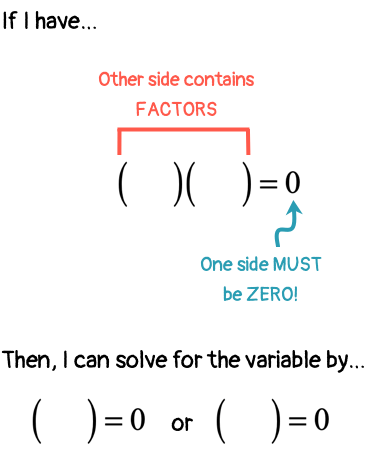
The diagram above suggests the following key points:
- One side of the equation is just zero.
- The opposite side should contain the factors of the given polynomial.
- After the two conditions stated above are met, then it is now OKAY to set each factor equal to zero then solve for the value of the unknown variable.
Examples of How to Solve Quadratic Equations using the Factoring Method
Example 1 : Solve the quadratic equation below by Factoring Method.

I consider this type of problem as a “freebie” because it is already set up for us to find the solutions. Notice that the left side contains factors of some polynomial, and the right side is just zero!
What we need to do is simply set each factor equal to zero, and solve each equation for [latex]x[/latex].
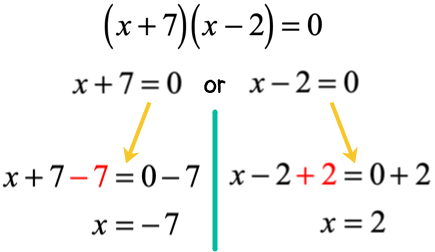
The answers are [latex]x = – \,7[/latex] and [latex]x = 2[/latex]. You may back-substitute these values of [latex]x[/latex] to the original equation to verify if they are true answers. I will leave it to you as an exercise.
Example 2 : Solve the quadratic equation below by Factoring Method.

The left side of the equation is a binomial. That means I can pull out a monomial factor. If you think about it, between the numerical coefficients [latex] – \,2[/latex] and [latex]6[/latex], I can factor out [latex] – \,2[/latex]. More so, between [latex]{x^2}[/latex] and [latex]x[/latex], I can factor out [latex]x[/latex]. So to find the overall factor (it’s like finding the GCF), I will multiply [latex] – \,2[/latex] and [latex]x[/latex] to get [latex] – \,2x[/latex].
Note, I can also factor out [latex]2x[/latex] instead of [latex] – \,2x[/latex]. The final answer should be the same. Try it out!
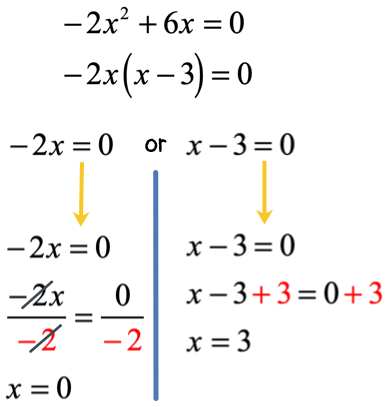
Example 3 : Solve the quadratic equation below using the Factoring Method.

Have you factored a trinomial before where the coefficient of the squared term is [latex] + 1[/latex]? If not, it is very simple.
To factor this trinomial into two binomials, I need to find two numbers (by trial and error) that satisfy two given conditions:
- The product of these two numbers is equal to the constant term (last number) which is [latex] – 10[/latex].
- The sum of these two numbers is equal to the coefficient of the linear term which is [latex] + 3[/latex].
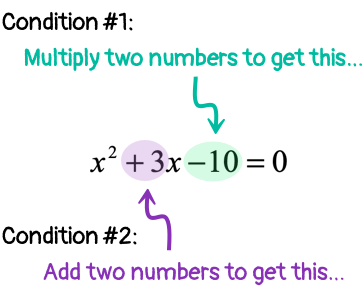
Since the product of two numbers is negative, I know that these numbers must have opposite signs. More so, having a sum of positive number implies that the number with the larger absolute value must be positive.
If you work it out mentally or using paper and pencil to run through possible combinations, the two numbers that can satisfy the given conditions are [latex] + 5[/latex] and [latex] – 2[/latex].
To check, their products [latex]\left( { + \,5} \right)\left( { – \,2} \right) = – 10[/latex], and their sum [latex]\left( { + \,5} \right)\,\, + \,\,\left( { – \,2} \right) = + 3[/latex]. Works out great!
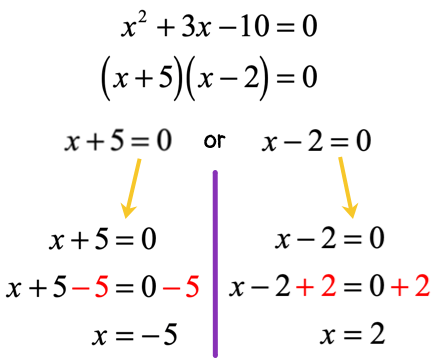
The final solutions are [latex]x = – \,5[/latex] and [latex]x = 2[/latex].
Example 4 : Solve the quadratic equation below using the Factoring Method.

Between the coefficients [latex]3[/latex] and [latex] – 27[/latex], I can pull out [latex]3[/latex]. And between [latex]{x^3}[/latex] and [latex]x[/latex], I can take out [latex]x[/latex]. Therefore the overall expression that I can factor out is their product: [latex]\left( 3 \right)\left( x \right) = 3x[/latex].
Notice that after I factored out [latex]3x[/latex], I am left with a “special” binomial called the “Difference of Two Squares” which is very easy to factor.
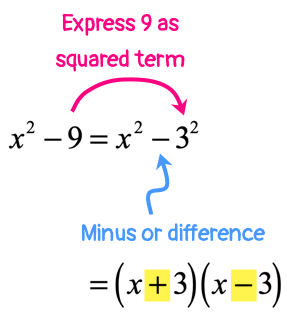
It is always the case that the middle signs will be opposites (see yellow ).
Here is the complete solution.

You should back-substitute to verify that [latex]x = 0[/latex], [latex]x = – \,3[/latex], and [latex]x = 3[/latex] are the correct solutions.
Example 5 : Solve the quadratic equation below using the Factoring Method.

The first thing I realize in this problem is that one side of the equation doesn’t contain zero . I can easily create a zero on the right side by subtracting both sides by [latex]20[/latex].
After doing so, the left side should have a factorable trinomial that is very similar to problem 3.
To factor out this trinomial, think of two numbers when multiplied together gives [latex] – 14[/latex] (constant term) and when added gives [latex] + 5[/latex] (coefficient of [latex]x[/latex]-term). By trial and error, the numbers should be [latex] – 2[/latex] and [latex]7[/latex]. You may verify this correct combination.
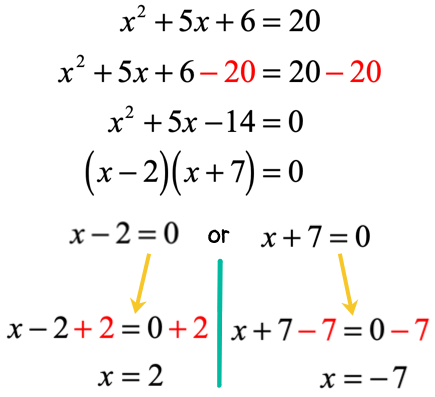
The final answers are [latex]x = 2[/latex] and [latex]x = – \,7[/latex].
Example 6 : Solve the quadratic equation below using the Factoring Method.

Here we have [latex]x = – \,6[/latex] and [latex]x = 7[/latex] as our final answers.
Example 7 : Solve the quadratic equation below using the Factoring Method.

Our final answers are [latex]x = 5[/latex] and [latex]x = 1[/latex].
Example 8 : Solve the quadratic equation below using the Factoring Method.

The final solutions are [latex]x = 1[/latex] and [latex]x = – \,3[/latex].
You might also like these tutorials:
- Solving Quadratic Equations by Square Root Method
- Solving Quadratic Equations by the Quadratic Formula
- Solving Quadratic Equations by Completing the Square

Want to create or adapt books like this? Learn more about how Pressbooks supports open publishing practices.
Chapter 7: Factoring
7.8 Solving Quadriatic Equations by Factoring
Solving quadratics is an important algebraic tool that finds value in many disciplines. Typically, the quadratic is in the form of [latex]y = ax^2 + bx + c[/latex], which when graphed is a parabola. Of special importance are the [latex]x[/latex]-values that are found when [latex]y = 0[/latex], which show up when graphed as the parabola crossing the [latex]x[/latex]-axis. For a trinomial, there can be as many as three [latex]x[/latex]-axis crossings. The following show the possible number of [latex]x[/latex]-axis intercepts for 2nd degree (quadratic) to 7th degree (septic) functions. Please note that if the fifth degree polynomial were shifted down a few values, it would also show 5 [latex]x[/latex]-axis intercepts. It is these [latex]x[/latex]-axis intercepts that are of interest.
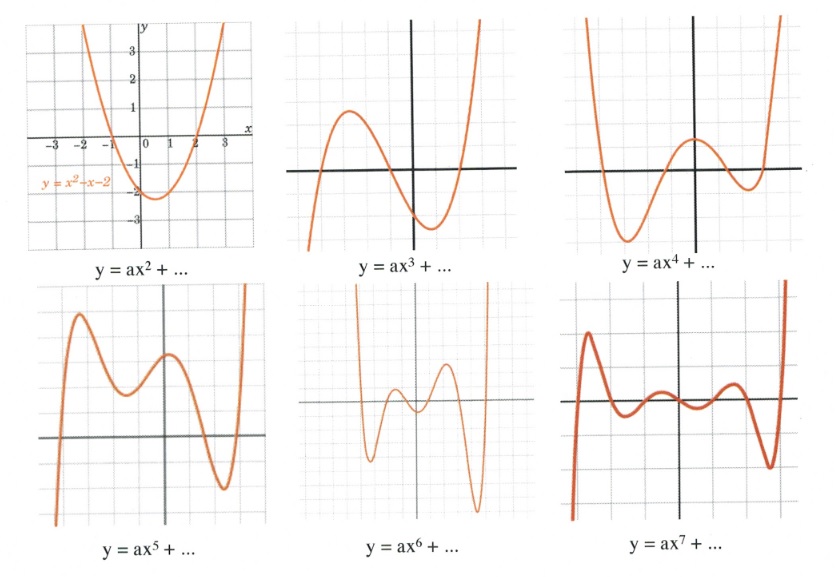
The approach to finding these [latex]x[/latex]-intercepts is elementary: set [latex]y = 0[/latex] in the original equation and factor it. Once the equation is factored, then find the [latex]x[/latex]-values that solve for 0. This is shown in the next few examples.
Example 7.8.1
Solve the following quadratic equation: [latex](2x - 3)(5x + 1) = 0[/latex].
In this problem there are two separate binomials: [latex](2x - 3)[/latex] and [latex](5x + 1)[/latex]. Since their product is equal to 0, there will be two solutions: the value for [latex]x[/latex] that makes [latex]2x - 3 = 0[/latex] and the value for [latex]x[/latex] that makes [latex]5x + 1 = 0[/latex].
[latex]\begin{array}{rrrrrcrrrrr} 2x&-&3&=&0&\hspace{0.15in}\text{and} \hspace{0.15in}&5x&+&1&=&0 \\ &+&3&&+3&&&-&1&&-1 \\ \hline &&2x&=&3&&&&5x&=&-1 \\ \\ &&x&=&\dfrac{3}{2}&&&&x&=&-\dfrac{1}{5} \end{array}[/latex]
Example 7.8.2
Solve the following polynomial equation: [latex](x - 3)(x + 3)(x - 1)(x + 1) = 0[/latex].
For this polynomial, there are four different solutions:
[latex](x - 3) = 0, (x + 3) = 0, (x - 1) = 0, (x + 1) = 0[/latex]
Solving for these four x-values gives us:
[latex]\begin{array}{rr} \begin{array}{rrrrr} x&-&3&=&0 \\ &+&3&&+3 \\ \hline &&x&=&3 \end{array} & \begin{array}{rrrrr} x&+&3&=&0 \\ &-&3&&-3 \\ \hline &&x&=&-3 \end{array} \end{array}[/latex]
[latex]\begin{array}{rr}\begin{array}{rrrrr} x&-&1&=&0 \\ &+&1&&+1 \\ \hline &&x&=&1 \end{array} & \begin{array}{rrrrr} x&+&1&=&0 \\ &-&1&&-1 \\ \hline &&x&=&-1 \end{array} \end{array}[/latex]
The solutions are: [latex]x=\pm 3, \pm 1[/latex].
It would be nice if there were only given factored equations to solve, but that is not how it goes. You are generally required to factor the equation first before it can be solved.
Example 7.8.3
Solve the following quadratic equation: [latex]4x^2 + x - 3 = 0[/latex].
First, factor [latex]4x^2 + x - 3[/latex] and get [latex](4x - 3)(x+1) = 0[/latex].
Now, solve for [latex]4x - 3 =0[/latex] and [latex]x + 1 = 0[/latex].
Solving these two binomials yields:
[latex]\begin{array}{rr} \begin{array}{rrrrr} \\ 4x&-&3&=&0 \\ &+&3&&+3 \\ \hline &&4x&=&3 \\ \\ &&x&=&\dfrac{3}{4} \end{array} &\hspace{0.25in} \begin{array}{rrrrr} x&+&1&=&0 \\ &-&1&&-1 \\ \hline &&x&=&-1 \\ \\ &&x&=&-1 \end{array} \end{array}[/latex]
Solve each of the following polynomials by using factoring.
- [latex](k - 7)(k + 2) = 0[/latex]
- [latex](a + 4)(a - 3) = 0[/latex]
- [latex](x - 1)(x + 4) = 0[/latex]
- [latex](2x + 5)(x - 7) = 0[/latex]
- [latex]6x^2 - 150 = 0[/latex]
- [latex]p^2 + 4p - 32 = 0[/latex]
- [latex]2n^2 + 10n - 28 = 0[/latex]
- [latex]m^2 - m - 30 = 0[/latex]
- [latex]7x^2 + 26x + 15 = 0[/latex]
- [latex]2b^2 - 3b - 2 = 0[/latex]
- [latex]x^2 - 4x - 8 = -8[/latex]
- [latex]v^2 - 8v - 3 = -3[/latex]
- [latex]x^2 - 5x - 1 = -5[/latex]
- [latex]a^2 - 6a + 6 = -2[/latex]
- [latex]7x^2 + 17x - 20 = -8[/latex]
- [latex]4n^2 - 13n + 8 = 5[/latex]
- [latex]x^2 - 6x = 16[/latex]
- [latex]7n^2 - 28n = 0[/latex]
- [latex]4k^2 + 22k + 23 = 6k + 7[/latex]
- [latex]a^2 + 7a - 9 = -3 + 6a[/latex]
- [latex]9x^2 - 46 + 7x = 7x + 8x^2 + 3[/latex]
- [latex]x^2 + 10x + 30 = 6[/latex]
- [latex]40p^2 + 183p - 168 = p + 5p^2[/latex]
- [latex]24x^2 + 11x - 80 = 3x[/latex]
Answer Key 7.8
Intermediate Algebra Copyright © 2020 by Terrance Berg is licensed under a Creative Commons Attribution-NonCommercial-ShareAlike 4.0 International License , except where otherwise noted.
Share This Book

log in help
to organize & manage your digital files & messages. Very soon, Dokkio will support Outlook as well as One Drive. Check it out today! | | | to the workspace. Already have an account? ! |
| | last edited by 3 years, 6 months ago | | | | | | 4/19 M | Solving Quadratic Equations by factoring ( ) | Factor quadratics to reveal zeroes to solve quadratic equations. | | | 4/20 T | Solving Quadratic Equations by factoring (a≠1) ( )
| Factor quadratics to reveal zeroes to solve quadratic equations. | | | 4/21 W | HW: Worksheet #1 HW: Worksheet #2 ( ) ( )
| | | | 4/22 Th | Solving Quadratic Equations by square rooting with completing the square intro ( )
| Complete the square of a quadratic to solve the equation. | | | 4/23 F | HW: Worksheet #3 ( ) | | | | 4/26 M | Solving Quadratic Equations by Completing the Square ( )
| Complete the square of a quadratic to solve the equation. | | | 4/27 T | HW: Worksheet #4 ( ) | | | | 4/28 W | Solving Quadratic Equations by Quadratic Formula ( )
| Solve quadratic equations using the quadratic formula. | | | 4/29 Th | HW: Worksheet #5 ( ) | | | | 4/30 F | ( ) | Assess the prior unit objectives. | | | 5/3 M | Mixed Practice ( ) | Asses the prior learning objectives | | | 5/4 T | | Asses the prior learning objectives | |
| | | | | | 3/27 (Day 2) & 3/30 (Day 3):
| Solving Quadratic Equations by factoring ( ) HW: Worksheet #1 ( ) | Factor quadratics to reveal zeroes to solve quadratic equations.
| | | 3/31 (Day 1) & 4/1 (Day 2):
| Solving Quadratic Equations by factoring (a≠1) ( ) HW: Worksheet #2 ( ) | Factor quadratics to reveal zeroes to solve quadratic equations.
| | | 4/1 (Day 2) & 4/2 (Day 3):
| Solving Quadratic Equations by square rooting with completing the square intro ( ) HW: Worksheet #3 ( ) | Complete the square of a quadratic to solve the equation.
| | | 4/3 (Day 1) & 4/13 (Day 2): | Solving Quadratic Equations by Completing the Square ( ) HW: Worksheet #4 ( ) | Complete the square of a quadratic to solve the equation.
| | | 4/13 (Day 2) & 4/14 (Day 3):
| Solving Quadratic Equations by Quadratic Formula ( ) HW: Worksheet #5 ( ) | Solve quadratic equations using the quadratic formula.
| | | 4/15 (Day 1) & 4/16 (Day 2):
| Mixed Practice ( ) HW: Worksheet #6 | Assess the prior unit objectives. | | | 4/16 (Day 2) & 4/17 (Day 3):
| ( ) HW: Study for Unit Test | Asses the prior learning objectives | | | 4/20 (Day 1) & 4/21 (Day 2): |
HW: End of Unit Review ( ) | Asses the prior learning objectives | | | | | | | | | | | |
Algebra To Go pages: 53-59, 239-249 *Disclaimer* You will need Microsoft Word or Adobe Acrobat Reader to read most of these files. These are only proposed schedules and can be changed at any time at my discretion, nothing is set in stone. Please use appropriately, thank you. Also, the date written is when the assignment has be given, the assumed due date is the following class period!!! Algebra Unit 8 | | Insert links to other pages or uploaded files. Loading... To turn text into a link, highlight the text, then click on a page or file from the list above. | Comments ( 0 )You don't have permission to comment on this page. PBworks / Help Terms of use / Privacy policy / GDPR About this workspace Contact the owner / RSS feed / This workspace is public Join this workspaceAlready have an account? Log in ! Contact Info Engage NY Favorite Websites Recent Activity Factorising Quadratics Practice QuestionsClick here for questions, click here for answers. Factorisation, quadratic GCSE Revision Cards  5-a-day Workbooks Primary Study Cards Privacy Policy Terms and Conditions Corbettmaths © 2012 – 2024  Quadratic Equation Worksheets (pdfs)Free worksheets with answer keys. Enjoy these free sheets. Each one has model problems worked out step by step, practice problems, as well as challenge questions at the sheets end. Plus each one comes with an answer key. - Solve Quadratic Equations by Factoring
- Solve Quadratic Equations by Completing the Square
- Quadratic Formula Worksheet (real solutions)
- Quadratic Formula Worksheet (complex solutions)
- Quadratic Formula Worksheet (both real and complex solutions)
- Discriminant Worksheet
- Sum and Product of Roots
- Radical Equations Worksheet
Ultimate Math Solver (Free) Free Algebra Solver ... type anything in there!Popular pages @ mathwarehouse.com.  Unit 8 – Quadratic Functions and Their AlgebraThese lessons introduce quadratic polynomials from a basic perspective. We then build on the notion of shifting basic parabolas into their vertex form. Completing the square is used as a fundamental tool in finding the turning point of a parabola. Finally, the zero product law is introduced as a way to find the zeroes of a quadratic function. Introduction to Quadratic Functions LESSON/HOMEWORK LECCIÓN/TAREA LESSON VIDEO EDITABLE LESSON EDITABLE KEY More Work with Parabolas The Shifted Form of a Parabola Completing the Square Stretching Parabolas and More Completing the Square The Zeroes of a Quadratic More Zero Product Law Work Quadratic Word Problems Unit Review Unit #8 Review – Quadratic Functions and Their Algebra UNIT REVIEW REPASO DE LA UNIDAD EDITABLE REVIEW Unit #8 Assessment Form A EDITABLE ASSESSMENT Unit #8 Assessment Form B Unit #8 Assessment Form C Unit #8 Assessment Form D Unit #8 Exit Tickets Unit #8 Mid-Unit Quiz (Through Lesson #4) – Form A Unit #8 Mid-Unit Quiz (Through Lesson #4) – Form B Unit #8 Mid-Unit Quiz (Through Lesson #4) – Form C U08.AO.01 – Perfect Square Warm-Up (Before Lesson #4) EDITABLE RESOURCE U08.AO.02 – Lesson #4.5.Axis of Symmetry Formula U08.AO.03 – Lesson #6.5.The Zeros of a Quadratic.Practice U08.AO.04 – Lesson #7.5.Solving Linear-Quadratic Systems U08.AO.05 – Lesson #9.Additional Quadratic Word Problems U08.AO.06 – Lesson #10.The Factored Form of a Polynomial U08.AO.07 – Practice Graphing Parabolas Thank you for using eMATHinstruction materials. In order to continue to provide high quality mathematics resources to you and your students we respectfully request that you do not post this or any of our files on any website. Doing so is a violation of copyright. Using these materials implies you agree to our terms and conditions and single user license agreement . The content you are trying to access requires a membership . If you already have a plan, please login. If you need to purchase a membership we offer yearly memberships for tutors and teachers and special bulk discounts for schools. Sorry, the content you are trying to access requires verification that you are a mathematics teacher. Please click the link below to submit your verification request. Quadratic Equations (Algebra 1 Curriculum - Unit 8) | All Things Algebra® What educators are sayingAlso included in.  DescriptionThis Quadratic Equations Unit Bundle contains guided notes, homework assignments, four quizzes, study guide and a unit test that cover the following topics: • Introduction to Quadratic Equations (Standard Form, Vertex, Axis of Symmetry, Maximum, Minimum) • Graphing Quadratic Equations by Table (Review of Domain/Range included) • Vertex Form and Transformations • Quadratic Roots (Identifying by Graphing) • The Discriminant • Solving Quadratic Equations by Factoring • Solving Quadratic Equations by Square Roots • Solving Quadratic Equations by Completing the Square • Solving Quadratic Equations by the Quadratic Formula • Review of all Methods • Applications: Area and Consecutive Integers • Projectile Motion • Linear vs. Quadratic Models ADDITIONAL COMPONENTS INCLUDED: (1) Links to Instructional Videos: Links to videos of each lesson in the unit are included. Videos were created by fellow teachers for their students using the guided notes and shared in March 2020 when schools closed with no notice. Please watch through first before sharing with your students. Many teachers still use these in emergency substitute situations. (2) Editable Assessments: Editable versions of each quiz and the unit test are included. PowerPoint is required to edit these files. Individual problems can be changed to create multiple versions of the assessment. The layout of the assessment itself is not editable. If your Equation Editor is incompatible with mine (I use MathType), simply delete my equation and insert your own. (3) Google Slides Version of the PDF: The second page of the Video links document contains a link to a Google Slides version of the PDF. Each page is set to the background in Google Slides. There are no text boxes; this is the PDF in Google Slides. I am unable to do text boxes at this time but hope this saves you a step if you wish to use it in Slides instead! Please download the preview to see a sample outline along with a collage of some of the pages. This resource is included in the following bundle(s): Algebra 1 Second Semester Notes Bundle Algebra 1 Curriculum Algebra 1 Curriculum (with Activities) More Algebra 1 Units: Unit 1 – Algebra Basics Unit 2 – Multi-Step Equations & Inequalities Unit 3 – Relations & Functions Unit 4 – Linear Equations Direct & Inverse Variation (Mini-Unit) Unit 5 – Systems of Equations & Inequalities Unit 6 – Exponents and Exponential Functions Unit 7 – Polynomials & Factoring Unit 9 – Linear, Quadratic, and Exponential Functions Unit 10 – Radical Expressions & Equations Unit 11 – Rational Expressions & Equations Unit 12 – Statistics LICENSING TERMS: This purchase includes a license for one teacher only for personal use in their classroom. Licenses are non-transferable , meaning they can not be passed from one teacher to another. No part of this resource is to be shared with colleagues or used by an entire grade level, school, or district without purchasing the proper number of licenses. If you are a coach, principal, or district interested in transferable licenses to accommodate yearly staff changes, please contact me for a quote at [email protected]. COPYRIGHT TERMS: This resource may not be uploaded to the internet in any form, including classroom/personal websites or network drives, unless the site is password protected and can only be accessed by students. © All Things Algebra (Gina Wilson), 2012-present Questions & AnswersAll things algebra. - We're hiring
- Help & FAQ
- Privacy policy
- Student privacy
- Terms of service
- Tell us what you think
- Solutions Integral Calculator Derivative Calculator Algebra Calculator Matrix Calculator More...
- Graphing Line Graph Exponential Graph Quadratic Graph Sine Graph More...
- Calculators BMI Calculator Compound Interest Calculator Percentage Calculator Acceleration Calculator More...
- Geometry Pythagorean Theorem Calculator Circle Area Calculator Isosceles Triangle Calculator Triangles Calculator More...
- Tools Notebook Groups Cheat Sheets Worksheets Study Guides Practice Verify Solution
 | | x^{\msquare} | \log_{\msquare} | \sqrt{\square} | \nthroot[\msquare]{\square} | \le | \ge | \frac{\msquare}{\msquare} | \cdot | \div | x^{\circ} | \pi | | \left(\square\right)^{'} | \frac{d}{dx} | \frac{\partial}{\partial x} | \int | \int_{\msquare}^{\msquare} | \lim | \sum | \infty | \theta | (f\:\circ\:g) | f(x) | | | ▭\:\longdivision{▭} | \times \twostack{▭}{▭} | + \twostack{▭}{▭} | - \twostack{▭}{▭} | \left( | \right) | \times | \square\frac{\square}{\square} | - Pre Algebra Order of Operations Factors & Primes Fractions Long Arithmetic Decimals Exponents & Radicals Ratios & Proportions Percent Modulo Number Line Expanded Form Mean, Median & Mode
- Algebra Equations Inequalities System of Equations System of Inequalities Basic Operations Algebraic Properties Partial Fractions Polynomials Rational Expressions Sequences Power Sums Interval Notation Pi (Product) Notation Induction Prove That Logical Sets Word Problems
- Pre Calculus Equations Inequalities Scientific Calculator Scientific Notation Arithmetics Complex Numbers Coterminal Angle Polar/Cartesian Simultaneous Equations System of Inequalities Polynomials Rationales Functions Arithmetic & Comp. Coordinate Geometry Plane Geometry Solid Geometry Conic Sections Trigonometry
- Calculus Derivatives Derivative Applications Limits Integrals Integral Applications Integral Approximation Series ODE Multivariable Calculus Laplace Transform Taylor/Maclaurin Series Fourier Series Fourier Transform
- Functions Line Equations Functions Arithmetic & Comp. Conic Sections Transformation
- Linear Algebra Matrices Vectors
- Trigonometry Identities Proving Identities Trig Equations Trig Inequalities Evaluate Functions Simplify
- Statistics Mean Geometric Mean Quadratic Mean Average Median Mode Order Minimum Maximum Probability Mid-Range Range Standard Deviation Variance Lower Quartile Upper Quartile Interquartile Range Midhinge Standard Normal Distribution
- Physics Mechanics
- Chemistry Chemical Reactions Chemical Properties
- Finance Simple Interest Compound Interest Present Value Future Value
- Economics Point of Diminishing Return
- Conversions Roman Numerals Radical to Exponent Exponent to Radical To Fraction To Decimal To Mixed Number To Improper Fraction Radians to Degrees Degrees to Radians Hexadecimal Scientific Notation Distance Weight Time Volume
- Pre Algebra
- One-Step Addition
- One-Step Subtraction
- One-Step Multiplication
- One-Step Division
- One-Step Decimals
- Two-Step Integers
- Two-Step Add/Subtract
- Two-Step Multiply/Divide
- Two-Step Fractions
- Two-Step Decimals
- Multi-Step Integers
- Multi-Step with Parentheses
- Multi-Step Rational
- Multi-Step Fractions
- Multi-Step Decimals
- Solve by Factoring
- Completing the Square
- Quadratic Formula
- Biquadratic
- Logarithmic
- Exponential
- Rational Roots
- Floor/Ceiling
- Equation Given Roots
- Equation Given Points
- Newton Raphson
- Substitution
- Elimination
- Cramer's Rule
- Gaussian Elimination
- System of Inequalities
- Perfect Squares
- Difference of Squares
- Difference of Cubes
- Sum of Cubes
- Polynomials
- Distributive Property
- FOIL method
- Perfect Cubes
- Binomial Expansion
- Negative Rule
- Product Rule
- Quotient Rule
- Expand Power Rule
- Fraction Exponent
- Exponent Rules
- Exponential Form
- Logarithmic Form
- Absolute Value
- Rational Number
- Powers of i
- Complex Form
- Partial Fractions
- Is Polynomial
- Leading Coefficient
- Leading Term
- Standard Form
- Complete the Square
- Synthetic Division
- Linear Factors
- Rationalize Denominator
- Rationalize Numerator
- Identify Type
- Convergence
- Interval Notation
- Pi (Product) Notation
- Boolean Algebra
- Truth Table
- Mutual Exclusive
- Cardinality
- Caretesian Product
- Age Problems
- Distance Problems
- Cost Problems
- Investment Problems
- Number Problems
- Percent Problems
- Addition/Subtraction
- Multiplication/Division
- Dice Problems
- Coin Problems
- Card Problems
- Pre Calculus
- Linear Algebra
- Trigonometry
- Conversions
| | x^{\msquare} | \log_{\msquare} | \sqrt{\square} | \nthroot[\msquare]{\square} | \le | \ge | \frac{\msquare}{\msquare} | \cdot | \div | x^{\circ} | \pi | | \left(\square\right)^{'} | \frac{d}{dx} | \frac{\partial}{\partial x} | \int | \int_{\msquare}^{\msquare} | \lim | \sum | \infty | \theta | (f\:\circ\:g) | f(x) | | | - \twostack{▭}{▭} | \lt | 7 | 8 | 9 | \div | AC | | + \twostack{▭}{▭} | \gt | 4 | 5 | 6 | \times | \square\frac{\square}{\square} | | \times \twostack{▭}{▭} | \left( | 1 | 2 | 3 | - | x | | ▭\:\longdivision{▭} | \right) | . | 0 | = | + | y | Number Line- ax^2+bx+c=0
- x^2+2x+1=3x-10
- 2x^2+4x-6=0
- How do you calculate a quadratic equation?
- To solve a quadratic equation, use the quadratic formula: x = (-b ± √(b^2 - 4ac)) / (2a).
- What is the quadratic formula?
- The quadratic formula gives solutions to the quadratic equation ax^2+bx+c=0 and is written in the form of x = (-b ± √(b^2 - 4ac)) / (2a)
- Does any quadratic equation have two solutions?
- There can be 0, 1 or 2 solutions to a quadratic equation. If the discriminant is positive there are two solutions, if negative there is no solution, if equlas 0 there is 1 solution.
- What is quadratic equation in math?
- In math, a quadratic equation is a second-order polynomial equation in a single variable. It is written in the form: ax^2 + bx + c = 0 where x is the variable, and a, b, and c are constants, a ≠ 0.
- How do you know if a quadratic equation has two solutions?
- A quadratic equation has two solutions if the discriminant b^2 - 4ac is positive.
quadratic-equation-calculator - High School Math Solutions – Quadratic Equations Calculator, Part 2 Solving quadratics by factorizing (link to previous post) usually works just fine. But what if the quadratic equation...
We want your feedbackPlease add a message. Message received. Thanks for the feedback.  | |




















IMAGES
VIDEO
COMMENTS
Name: _____ Unit 8: Quadratic Equations Date: _____ Homework 6: Solving Quadratics by Factoring Solve each quadratic equation by factoring. 1. 2x2 - 8x - 24 = 0 2. 5x2 + 5x - 30 = 0 3. 4x2 + 12x + 8 = 0 4. 3x2 - 15x + 12 = 0 5. 3x2 - 7x - 6 = 0 6. 2x2 + 5x + 3 = 0 7. 4x2 - 19x - 5 = 0 8. 10x2 - x - 2 = 0 ** This is a 2-page document!
Lesson #5 Homework Use the method completing the square to write each of the following quadratic ftnctions in the y = a + k. Then, identifÿthe tuning point and whether it is a maximum or minimum. (a) y=3x2—12x+17 (b) +40x—70 Which of the following equations models the graph shown at the right? Explain how you made your choice? y = (x+1)2 ...
Unit 8 - Quadratic Equations: Sample Unit Outline TOPIC HOMEWORK DAY 1 Introduction to Quadratic Equations: Standard Form, Axis of Symmetry, Vertex, Minimum, Maximum ... Quadratic Equation; Transformations HW #3 DAY 4 Quiz 8-1 None DAY 5 Quadratic Roots and the Discriminant HW #4 DAY 6 Solving Quadratics by Factoring (Day 1) HW #5 DAY 7 ...
Unit 8: quadratics Date Homework 5 Hour Homework 5: Solving Quadratics by Factoring (Day 1) Directions : Answer all questions. Show all work!!! Learning Target: I CAN solve quadratics by factoring. D i r e c t i o n s : S o l v e e ac h q u a dr ati c e q uat ion by f act o rin g . 1. x 2+7x +12=0 2.
Unit 8 - Solving Quadratic Equations. Unit 8 - Videos. Lesson 1 (stop at 3:05) Lessons 2 - 4. Lessons 6 (stop at 6:45) Lesson 8 (start at 6:50) Lessons 9-10. Lesson 12. Lesson 13. Lesson 14. Unit 8 - Answer Keys. Lesson #1 Simplifying Radicals Lesson #2 Intro to Quadratics (Day 1) Lesson #3 Solving Quadratic Equations (Day 2) Lesson #4 Solving ...
Describe the transformations from the parent function given each equation. 7. +6 R€Ç(ec4ed acnss -HAL LeB q and Down 9 y —5)2 +4 sye4ch 2, 10. If the graph of the function y = x2 is reflected over the x-axis, then translated two units left, write an equation to represent the function. Topic 5: Quadratic Roots (Zeros) 11.
There are always 2 solutions to quadratics. Set the quadratic = 0 and solve for x. There are with three possibilities: a) 2 real number solutions. b) 1 repeated solution (so it counts as 2). Can be real or complex. c) 2 complex number solutions. Solve by Graphing. Use when the function's graph is available and it has x-intercepts.
Unit 8: Factoring (Solving Quadratics by Factoring) Day Lesson Topic Textbook Section Homework 1 U8: L1 ... 10.5-10.6 Unit 8 Practice Quiz 2 12 U8: QUIZ 2 QUIZ 2 10.5-10.6 ... Factor "Completely" and Solving Polynomials Equations by Factoring 10.8 Factoring Packet # 131 - 140 ALL Factoring Packet # 152 - 160 Even 15 U8: L7 ...
Main Idea of using Factoring Method to Solve a Quadratic Equation. The diagram above suggests the following key points: The opposite side should contain the factors of the given polynomial. After the two conditions stated above are met, then it is now OKAY to set each factor equal to zero then solve for the value of the unknown variable ...
If you're seeing this message, it means we're having trouble loading external resources on our website. If you're behind a web filter, please make sure that the domains *.kastatic.org and *.kasandbox.org are unblocked.
The solutions are: x = ±3,±1 x = ± 3, ± 1. It would be nice if there were only given factored equations to solve, but that is not how it goes. You are generally required to factor the equation first before it can be solved. Example 7.8.3. Solve the following quadratic equation: 4x2 +x− 3 = 0 4 x 2 + x − 3 = 0.
Introduction. When a polynomial is set equal to a value (whether an integer or another polynomial), the result is an equation. An equation that can be written in the form \(\ a x^{2}+b x+c=0\) is called a quadratic equation.You can solve a quadratic equation using the rules of algebra, applying factoring techniques where necessary, and by using the Principle of Zero Products.
Unit 8 - Quadratic Functions. Lesson 1 Introduction to Quadratic Functions. ... Solving Quadratic Equations Using Inverse Operations. LESSON/HOMEWORK. LECCIÓN/TAREA. LESSON VIDEO. ANSWER KEY. ... More Work Factoring to Solve Quadratics. LESSON/HOMEWORK. LECCIÓN/TAREA. LESSON VIDEO. ANSWER KEY. EDITABLE LESSON.
Factor quadratics to reveal zeroes to solve quadratic equations. AU8 - 1 notes answers.pdf. Lesson 2. 4/20 T . Solving Quadratic Equations by factoring (a≠1) (AU8 - Lesson 2 notes - factoring complex.docx) AU8L#2 Video. Factor quadratics to reveal zeroes to solve quadratic equations. AU8 - 2 notes answers.pdf . Lesson 3. 4/21 W . HW: Worksheet #1
Solving Quadratic Equations by Factoring. An equation containing a second-degree polynomial is called a quadratic equation. For example, equations such as 2 x 2 + 3 x − 1 = 0 2 x 2 + 3 x − 1 = 0 and x 2 − 4 = 0 x 2 − 4 = 0 are quadratic equations. They are used in countless ways in the fields of engineering, architecture, finance ...
When this is the case, you can factor the trinomial on the left-side of the equation as follows: Figure 04: How to solve quadratic equations by factoring. Step One: Identify the values of b and c. In this example, the values of b and c are: b=6 & c=8. Step Two: Find two numbers that both ADD to b and MULTIPLY to c.
AI generated content may present inaccurate or offensive content that does not represent Symbolab's view. Solve quadratic equations using factoring step-by-step. High School Math Solutions - Quadratic Equations Calculator, Part 1. A quadratic equation is a second degree polynomial having the general form ax^2 + bx + c = 0, where a, b, and c...
Practice Questions. Previous: Expanding Two Brackets Practice Questions. Next: Solving Quadratics Practice Questions. Click here for Questions . Click here for Answers . Factorisation, quadratic.
Enjoy these free sheets. Each one has model problems worked out step by step, practice problems, as well as challenge questions at the sheets end. Plus each one comes with an answer key. Solve Quadratic Equations by Factoring. Solve Quadratic Equations by Completing the Square. Quadratic Formula Worksheets.
Unit 8 - Quadratic Functions and Their Algebra. These lessons introduce quadratic polynomials from a basic perspective. We then build on the notion of shifting basic parabolas into their vertex form. Completing the square is used as a fundamental tool in finding the turning point of a parabola. Finally, the zero product law is introduced as a ...
This product contains 14 pages of guided notes for a Math for College Algebra course - Unit 8: Quadratic Equations and Functions. 5 lessons included. · Lesson 8 .1: Solving Quadratic Equations · Lesson 8 .2: Completing the Square· Lesson 8 .3: The Quadratic Formula· Lesson 8 .4: Graphs of Quadratic Functions · Lesson 8 .5: Application.
This Quadratic Equations Unit Bundle contains guided notes, homework assignments, four quizzes, study guide and a unit test that cover the following topics:• Introduction to Quadratic Equations (Standard Form, Vertex, Axis of Symmetry, Maximum, Minimum) • Graphing Quadratic Equations by Table (Revie...
To solve a quadratic equation, use the quadratic formula: x = (-b ± √ (b^2 - 4ac)) / (2a). There can be 0, 1 or 2 solutions to a quadratic equation. If the discriminant is positive there are two solutions, if negative there is no solution, if equlas 0 there is 1 solution. In math, a quadratic equation is a second-order polynomial equation in ...